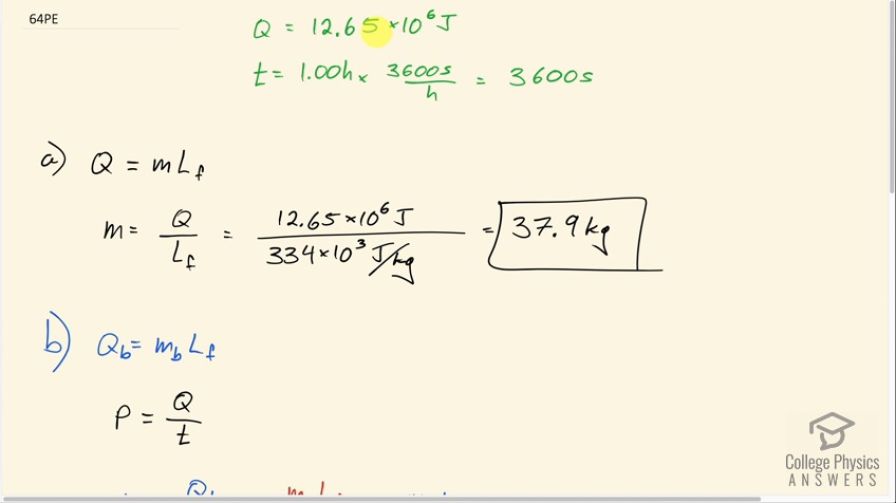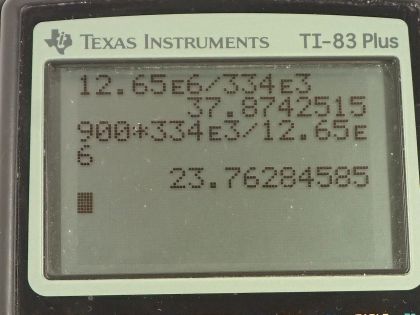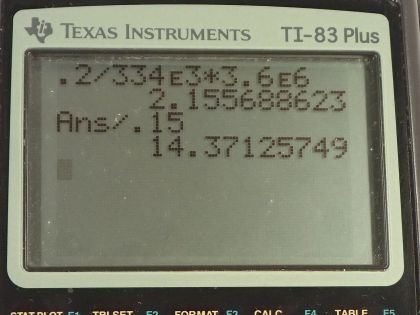Question
In an air conditioner, 12.65 MJ of heat transfer occurs from a cold environment in 1.00 h. (a) What mass of ice melting would involve the same heat transfer? (b) How many hours of operation would be equivalent to melting 900 kg of ice? (c) If ice costs 20 cents per kg, do you think the air conditioner could be operated more cheaply than by simply using ice? Describe in detail how you evaluate the relative costs.
Final Answer
- Ice cost = . The typical cost for electricity is . The cost of cooling with ice is greater than that by using the air conditioner by a factor of .
Solution video
OpenStax College Physics for AP® Courses, Chapter 15, Problem 64 (Problems & Exercises)

vote with a rating of
votes with an average rating of
.
Calculator Screenshots
Video Transcript
This is College Physics Answers with Shaun Dychko. An air conditioner transfers 12.65 megajoules which is times 10 to the 6 joules of heat energy out of a cold room in 1 hour and part (a) of this question asks what mass of ice would involve the same heat transfer? So the heat that the ice would absorb is its mass times its latent heat of fusion and so we can divide both sides by L f to solve for m and so the mass would be the heat absorbed which is 12.65 times 10 to the 6 joules divided by the latent heat of fusion which is 334 times 10 to the 3 joules per kilogram and that makes 37.9 kilograms. Part (b) asks us how many hours of operation would be equivalent to melting 900 kilograms of ice? So we'll figure out what amount of energy that would be in melting 900 kilograms of ice and that will be 900 kilograms times latent heat of fusion and then... we know the power of the air conditioner is this heat Q that we are given divided by the time which we'll express in hours actually because it's asking us for the number of hours in the end in part (b) here. So the time in the case of this 900 kilograms of ice equivalent melting will be the amount of heat that would be absorbed by 900 kilograms of ice, m b, times latent heat of fusion and we'll divide that by the power. Now the power is Q over t and Q being this 12 times 12.65 times 10 to the 6 joules and the time being this 1 hour— this is the reciprocal of the power of the air conditioner— so here's the amount of heat that is meant to be absorbed 900 kilograms times 334 times 10 to the 3 joules per kilogram and then we are multiplying by the reciprocal of the air conditioner power which is the same as dividing by the power and this works out to 23.8 hours. And part (c) asks us to compare the cost of using ice to cool the room versus the air conditioner. So ice is 20 cents per kilogram and then we multiply that by 1 kilogram of mass used up for every 334 times 10 to the 3 joules of heat absorbed— that's the latent heat of fusion— and I have written it as a reciprocal of what we normally write normally it's 334 times 10 to the 3 joules per kilogram but I know to write the reciprocal so that these units cancel and we are left with dollars per joule but to compare with the cost of electricity, it would be nice to have it dollars per kilowatt-hour because electricity bills are usually expressed that way. So we multiply by 3.600 times 10 to the 6 joules for every kilowatt-hour and if you are not sure where this conversion comes from, you can say that 1 kilowatt hour multiplied by 1000 watts per kilowatt—this cancels the kilowatts— and then times by 3600 seconds per hour— this cancels the hours— and this leaves us with watt-seconds, which is joules, and this is 3600 times a 1000 is 3.600 times 10 to the 6 and watt-seconds are joules. Okay so that's where this comes from. This works out to 2 dollars and 16 cents per kilowatt-hour is the cost of using ice. Typical electrical bill will charge 15 cents per kilowatt-hour and so this ice cost is greater by a factor of 14.4 when you divide the cost of the ice per kilowatt-hour by the price of electricity per kilowatt-hour.

